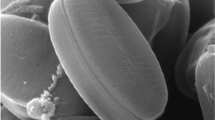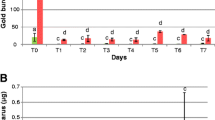Summary
The bioaccumulation of gold in trace concentration by Nitzschia obtusa and Navicula minima, two members of bacillariophyceae, has been studied. It has been observed that Nitzschia obtusa showed better accumulation of gold in acidic pH in comparison to neutral and basic pH. Maximum accumulation was observed with 1 mg . kg-1 or less gold concentration. However, the accumulation by the living cells was reduced when the matrix concentration was higher. Navicula minima, on the other hand, found to be a better accumulator of gold in wide ranges of pH and substrate concentration of the media. It was also inferred that the gold accumulation by diatom was mainly due to adsorption by biosilica (siliceous frustules of dead diatom cells). Accumulated gold was recovered with conc. HNO3.
Similar content being viewed by others
Author information
Authors and Affiliations
Rights and permissions
About this article
Cite this article
Chakraborty, N., Pal, R., Ramaswami, A. et al. Diatom: A potential bio-accumulator of gold. J Radioanal Nucl Chem 270, 645–649 (2006). https://doi.org/10.1007/s10967-006-0475-0
Issue Date:
DOI: https://doi.org/10.1007/s10967-006-0475-0




